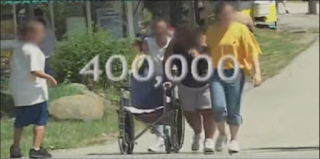 The show starts with hard-hitting facts and they are visualised on the screen to show how extreme they are. This certainly draws the viewer in right away to the subject matter and immediately we know what this show is about. I certainly admire the fact they have got the point of the documentary across within the first few minutes of the documentary. As for the graphics, I think they work well depending on the topic matter. It works well in Supersize me as they are trying to expose a fact and make it available to a wider audience. The graphics consolidate the point they are trying to make and if the graphics were not there, for some people, it may be hard to put into perspective how big of an issue fast food and people's weight is. I personally went backwards and forth thinking what would be best for our documentary, we aren't particularly trying to tell the viewer how bad a situation is via attention-grabbing facts, rather actuality sequences where the presenter is put through a number of tasks to reach an end goal. I personally feel graphics would come off tacky and look very out of place in our documentary. Especially, as I will talk about later, I want to take a more cinematic approach to film in comparison to this documentary and graphics on screen would not fit that directorial style.
The show starts with hard-hitting facts and they are visualised on the screen to show how extreme they are. This certainly draws the viewer in right away to the subject matter and immediately we know what this show is about. I certainly admire the fact they have got the point of the documentary across within the first few minutes of the documentary. As for the graphics, I think they work well depending on the topic matter. It works well in Supersize me as they are trying to expose a fact and make it available to a wider audience. The graphics consolidate the point they are trying to make and if the graphics were not there, for some people, it may be hard to put into perspective how big of an issue fast food and people's weight is. I personally went backwards and forth thinking what would be best for our documentary, we aren't particularly trying to tell the viewer how bad a situation is via attention-grabbing facts, rather actuality sequences where the presenter is put through a number of tasks to reach an end goal. I personally feel graphics would come off tacky and look very out of place in our documentary. Especially, as I will talk about later, I want to take a more cinematic approach to film in comparison to this documentary and graphics on screen would not fit that directorial style.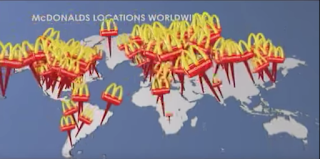
Saying this, I did rather like the map with McDonald's plotted on a world map. The graphic did not linger and was only on the screen for a second, but like with the facts on screen, it really proved a point. Right away the viewer is felt astonished that there are so many McDonalds there are and for me personally it definitely made me think about how bad the modern world is to depend on fast food as much as we seemingly do. But once again, while thinking of sequences for our own documentary, I find it hard to think of a scenario right now that would warrant a large graphic on the screen. I personally feel both documentaries are trying to expose a hidden truth about the subject matter, but that does not mean they have to follow exactly the same Formula. As of writing this, I find it hard to think of a moment in our documentary that would warrant a large graphic. However, once I sit down with the team in January they may have a few ideas about how they could be implemented. I am certainly not counting out the use of graphics, but I personally struggle to see how they would help us tell our story better.
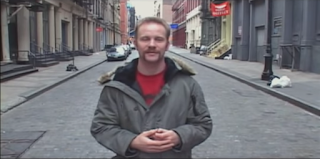
One small directorial decision I noticed was that the opening piece to camera was shot in an empty street with a wide angle lens on the camera. This is a somewhat daunting camera shot that is probably trying to show the scale of this documentary. I think this shot is being used to heighten the drama within the piece. The presenter is looking right at the camera and it is not a candid piece to camera in a car or walking. This is very direct and formal. I think this is being used to make sure the viewer realises, while there may be silly and funny moments during the documentary, the underlying message is that this is a serious topic that we all need to respect. This certainly made me think further about how we could open our documentary. I have various ways of opening it in my mind, a dramatic exercise sequence with panting breath, a car shot of a flashforward from the ending race day sequence or now, something like this. I personally feel this works well for supersize me. It focuses the viewer on the presenter and lets us see him before we start the challenge. This is important as we get an opening sequence to the camera which enables us to connect to him before he does anything. Without this PTC, we could lose that "bond" we have and need with the presenter to make the show intriguing and successful. I did personally not think about opening up our documentary this way, but this has certainly given me another way of opening our documentary.

The use of professionals quite early on in the documentary certainly put another layer of intrigue into this documentary. As professionals, they give the documentary more authenticity and it instantly makes the issue as important as it is. I did find the approach to feature them so early interesting, though. Personally, I would have liked to know more about the presenter and why he is attempting this challenge before we got to this sequence. You almost feel a little overwhelmed in the opening stages of Supersize Me as you have so many facts being told and shown on screen, it is hard to take them all in. I personally feel the opening 10 minutes of this documentary was to insense and rather dumps them on the viewer with facts and opinions. Saying this - The use of professionals is something I had somewhat overlooked while originally planning my documentary. I had one or two people, but probably not enough to make it feel involved in the subject matter. After thinking about other ways to include professionals I think I have a few ideas that will work for us. This was an important learning experience from watching this documentary. As without the figure of knowledge in your documentary, it is hard for there to be trust between the viewer and the documentary, as well as the documentary not having solid evidence behind it.
One small feature that I noticed was used throughout was the use of a soundtrack that built up to an event. The soundtrack was also used to set the tone for most sequences. As the documentary mixes between funny and happy moments and sad and serious moments it helps the viewer understand what they are supposed to feel in a certain moment. The sound is something that is sometimes overlooked and I have found in some of my previous projects that the sound has let down the project. In our group, we want to try and commision an original soundtrack, but I will also be working closely with George and Cailan to make sure the tone is correct through from pre-production all the way to the end of the editing stage. I think that this documentary does a great job with its use of sound. It certainly adds another layer to the show and makes sure the viewer feels the emotions that the directors and presenter were intending you to feel when they were making this show.
 To make sure that this documentary is scientific, they include a sequence where the presenter goes through a fitness test and also weigh him and find out his general health. This sequence is vital in this documentary as it gives us a reference point for later in the documentary when they see what has happened. This sequence isn't drawn out and is almost played out like a montage. I think this sequence is not only interesting but placed in the documentary very well. This sequence made me think about how we can reference my journey and how we can show the evolution of my driving skills as well as myself as a person. I feel we should certainly have a sequence in our documentary near the start which shows me in the early stages and how I am. We could also do a fitness test, like in Supersize me. I could also show my development by showing my lap times of the circuit on my home racing simulator, this will hopefully show that I have got quicker! This sequence will be important in our documentary and I feel we should certainly have one in ours. I will brainstorm more ideas and discuss with Cailan and George about what else we could do to show evolution in myself.
To make sure that this documentary is scientific, they include a sequence where the presenter goes through a fitness test and also weigh him and find out his general health. This sequence is vital in this documentary as it gives us a reference point for later in the documentary when they see what has happened. This sequence isn't drawn out and is almost played out like a montage. I think this sequence is not only interesting but placed in the documentary very well. This sequence made me think about how we can reference my journey and how we can show the evolution of my driving skills as well as myself as a person. I feel we should certainly have a sequence in our documentary near the start which shows me in the early stages and how I am. We could also do a fitness test, like in Supersize me. I could also show my development by showing my lap times of the circuit on my home racing simulator, this will hopefully show that I have got quicker! This sequence will be important in our documentary and I feel we should certainly have one in ours. I will brainstorm more ideas and discuss with Cailan and George about what else we could do to show evolution in myself.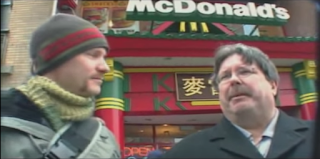 Another sequence that inspired me was the sequence in which the presenter goes into the public and tried to understand more about the size of the issue and what people think about the issue. This is shot handheld and not very cinematic, but it gets the point across efficiently and in an authentic way. As these interviews with the public are not set up in advance, as the documentary maker you would not be sure exactly what is going to be said, but it does make the opinions more authentic and real. I'm not sure our subject would work so well with going up to random people, as our subject matter is not as broad as fast food. But I definitely think we should go to a kart track, where young racers are starting their careers. We should ask questions about costs, level of talent and motivation and fitness. I think this would help give another angle on our documentary as we get to see what people who want to make a career out of motorsport think about its incredible highs and tough lows. I think this sequence will help the viewer understand motorsport and passion of the people on track. I feel our interviews may be staged a little more as we will need to be in contact before the event, but I think it may be best to keep the questions to ourselves so that we get authentic answers on the day.
Another sequence that inspired me was the sequence in which the presenter goes into the public and tried to understand more about the size of the issue and what people think about the issue. This is shot handheld and not very cinematic, but it gets the point across efficiently and in an authentic way. As these interviews with the public are not set up in advance, as the documentary maker you would not be sure exactly what is going to be said, but it does make the opinions more authentic and real. I'm not sure our subject would work so well with going up to random people, as our subject matter is not as broad as fast food. But I definitely think we should go to a kart track, where young racers are starting their careers. We should ask questions about costs, level of talent and motivation and fitness. I think this would help give another angle on our documentary as we get to see what people who want to make a career out of motorsport think about its incredible highs and tough lows. I think this sequence will help the viewer understand motorsport and passion of the people on track. I feel our interviews may be staged a little more as we will need to be in contact before the event, but I think it may be best to keep the questions to ourselves so that we get authentic answers on the day.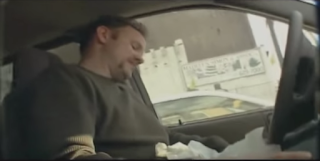 Sequences that frequently appear in documentaries like this are car shots where the presenter gives opinions and thoughts and sometimes opens up to the camera more as the shots are not staged and have no moments of wondering what needs to be said. These sequences are great for when something important has happened in the documentary and we want to understand what the presenter is really thinking. They are not particularly cinematic but they add a humanising factor into any documentary where it is easy for the documentary to cut out sequences like this if they want to make it seem like things are easier than is a reality. Speaking with George and hearing his opinions about some of the reference material I sent him. He said car shots helped move the story along and helped us connect with the person who is going on this journey. I personally think these moments help us see the evolution of the presenter throughout the documentary as they feel like they are in a safe place and feel more comfortable in opening up and airing their honest thoughts. These shots are handheld and raw and I think these works really well in self-exploratory documentaries as we capture the presenter in a comfortable environment. We will certainly be using similar shots and sequences in our documentary as we will be able to show the journey in the most authentic way.
Sequences that frequently appear in documentaries like this are car shots where the presenter gives opinions and thoughts and sometimes opens up to the camera more as the shots are not staged and have no moments of wondering what needs to be said. These sequences are great for when something important has happened in the documentary and we want to understand what the presenter is really thinking. They are not particularly cinematic but they add a humanising factor into any documentary where it is easy for the documentary to cut out sequences like this if they want to make it seem like things are easier than is a reality. Speaking with George and hearing his opinions about some of the reference material I sent him. He said car shots helped move the story along and helped us connect with the person who is going on this journey. I personally think these moments help us see the evolution of the presenter throughout the documentary as they feel like they are in a safe place and feel more comfortable in opening up and airing their honest thoughts. These shots are handheld and raw and I think these works really well in self-exploratory documentaries as we capture the presenter in a comfortable environment. We will certainly be using similar shots and sequences in our documentary as we will be able to show the journey in the most authentic way.From my experience in documentary making, it is sometimes hard to get all of the facts and opinions to the viewers via pieces to camera and actuality sequences. The use of voiceover is then vital in filling in the gaps and helping guide the story. I think Supersize Me uses voiceover when it feels facts were left out or need reinforcing. This made me think about voiceover placement in our documentary. It can be very powerful in helping broadcast the emotions that you want the viewer to feel. As you can script the voiceover, it enables the voiceover to present facts and figures in a way that feels more natural than a piece to camera which, in a piece like, this may seem too forced. In our documentary I think we can use voiceover in actuality sequences where the presenter gives opinions on what is going on from a perspective after the footage has been reviewed. This can help add further context if there is something that happens at the time but it does not feel correct when filming to record a piece to camera. The use of voiceover will be a powerful tool in helping us move our story along and make sure authentic opinions are being shared.
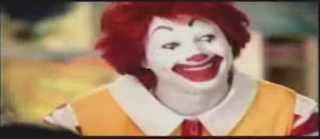 Another filmmaking technique that proved successful in Supersize Me is the use of archive footage and reference material. In the case of supersize me, it allows the viewer to understand the scale of the issue and why fast food chains are brainwashing children with the amount of advertising. However, I feel in our documentary we can use reference material and archive footage to show how much motorsport means to me. I had old photos and videos of myself when I was younger attending events that got me hooked into motorsports. These reference clips will also show why this project is important to me and why I am willing to undergo all the stress of getting ready for a race. This material should also help connect the viewer to the presenter as they get to know me on another level, rather than just someone who wants to challenge themselves. I think the reference material could be occupied with either voiceover or with a piece to camera where I explain my history with the sport. Archive material always helps show the journey of the documentary. It shows that the documentary is, in fact, a small part of a long journey in motorsport which started many years before. This will also enable me to rewatch this archive material which will be nice and possibly bring out different emotions when filming.
Another filmmaking technique that proved successful in Supersize Me is the use of archive footage and reference material. In the case of supersize me, it allows the viewer to understand the scale of the issue and why fast food chains are brainwashing children with the amount of advertising. However, I feel in our documentary we can use reference material and archive footage to show how much motorsport means to me. I had old photos and videos of myself when I was younger attending events that got me hooked into motorsports. These reference clips will also show why this project is important to me and why I am willing to undergo all the stress of getting ready for a race. This material should also help connect the viewer to the presenter as they get to know me on another level, rather than just someone who wants to challenge themselves. I think the reference material could be occupied with either voiceover or with a piece to camera where I explain my history with the sport. Archive material always helps show the journey of the documentary. It shows that the documentary is, in fact, a small part of a long journey in motorsport which started many years before. This will also enable me to rewatch this archive material which will be nice and possibly bring out different emotions when filming.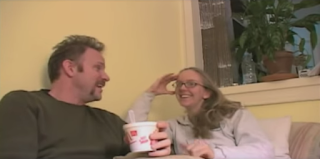 The use of actuality sequences in Supersize me also enable us to connect to the presenter. As we get further and further into the documentary we start to learn the special quirks of the presenter and we feel we know them by the end of the show. Even if the actuality sequences are filmed rough and do not have much of a cinematic approach to them, what is important in these sequences is the growing connection between the viewer and the filmmakers and presenter. If everything was set up and formal it may not allow the viewer to connect and feel the emotions as well as if they are shot rough and "on the go". While I want our documentary to be more cinematic and have a long list of shot styles than Supersize Me, what the programme has enabled me to learn is that sometimes an actuality sequence is important in keeping the documentary truthful to itself and the viewer. Sometimes over-complicating a scene for cinematic quality loses the reality of a situation and then invalidates the point we will be trying to prove. The hard, honest, truth about motorsport won't be fully shown through lovely stylises shots. Rough sequences where you connect to the viewer will be important in the presenter's journey and the documentaries evolution.
The use of actuality sequences in Supersize me also enable us to connect to the presenter. As we get further and further into the documentary we start to learn the special quirks of the presenter and we feel we know them by the end of the show. Even if the actuality sequences are filmed rough and do not have much of a cinematic approach to them, what is important in these sequences is the growing connection between the viewer and the filmmakers and presenter. If everything was set up and formal it may not allow the viewer to connect and feel the emotions as well as if they are shot rough and "on the go". While I want our documentary to be more cinematic and have a long list of shot styles than Supersize Me, what the programme has enabled me to learn is that sometimes an actuality sequence is important in keeping the documentary truthful to itself and the viewer. Sometimes over-complicating a scene for cinematic quality loses the reality of a situation and then invalidates the point we will be trying to prove. The hard, honest, truth about motorsport won't be fully shown through lovely stylises shots. Rough sequences where you connect to the viewer will be important in the presenter's journey and the documentaries evolution.One scene that stood out to me in the show, is one where they show an operation, it is quite graphic and shows scenes that will disturb many viewers. I found this sequence very uncomfortable to watch but I understand why it is there. The sequence is used to being a shock factor to the viewer to make them think hard about themselves and if they want something like this to happen to them. The use of needles as well as one that always affects me personally as I hate them! I personally would not like to go as graphic as this with our scenes, but as I am the presenter I will not be allowed to confirm exactly which scenes will be shown. If George as the editor thinks we should include them, then I will have to go by his word. If we wanted to include a sequence that includes shock factor, we could do something similar with a fitness test which pushes the presenter to the extreme. Another scenario could be an intense cycling or running scene in which the presenter is seen to be in pain which could be hard to watch as a viewer. Another way we could show a brutal sequence would be during an online race, we could see the stress that the presenter goes through when learning the circuit on an online gaming simulator. This last one, however, may not create a lot of emotion as a lot of people judge video games and may not think it is a serious sequence.
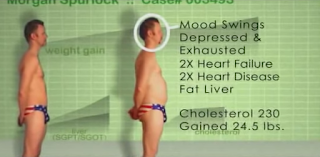 I think the conclusion to this documentary is very solid and backed up with hard truths and facts which leaves the viewer thinking about their personal situations. Referencing back to the earlier point in the documentary, they were able to compare the figures from the start to the end of the documentary. In this circumstance, it was seeing how much weight he gained and other issues he developed. Our documentary cannot really end the same way that this documentary ends as we won't have a factor we can measure at the start and the end. We will most certainly be able to see the evolution of lap times on video game simulators, but that will be finalised before my first race. I see our ending being something along the lines of "motorsport really is hard, you will have to make a lot of sacrifices to make it in this sport" and hopefully, that will have been proven throughout my journey into motorsport. How exactly this closing statement will be shot and presented is to be confirmed and I hope future reference material will be able to help me decide which way would be best in concluding our documentary.
I think the conclusion to this documentary is very solid and backed up with hard truths and facts which leaves the viewer thinking about their personal situations. Referencing back to the earlier point in the documentary, they were able to compare the figures from the start to the end of the documentary. In this circumstance, it was seeing how much weight he gained and other issues he developed. Our documentary cannot really end the same way that this documentary ends as we won't have a factor we can measure at the start and the end. We will most certainly be able to see the evolution of lap times on video game simulators, but that will be finalised before my first race. I see our ending being something along the lines of "motorsport really is hard, you will have to make a lot of sacrifices to make it in this sport" and hopefully, that will have been proven throughout my journey into motorsport. How exactly this closing statement will be shot and presented is to be confirmed and I hope future reference material will be able to help me decide which way would be best in concluding our documentary.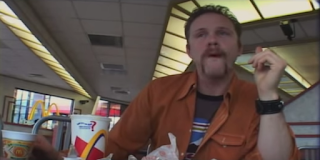 This documentary has helped me learn about storytelling techniques through documentaries in which the presenter goes on a journey. It helped me think of new ideas to include in our documentaries, including speaking to people who are in a similar situation, for example, young go-karters who want to make a career out of the sport. The importance of car shots to show raw unedited emotion will also be vital in helping the story move along and letting the viewer know the presenter better. The use of sound including both a soundtrack and voiceover was also worth understanding as they can help add another layer to a documentary which helps immerse the viewer. It did also show me certain techniques I did not want to heavily rely on, like graphics and also made me think how I wanted my shots to be generally more cinematic than the shots they used.
This documentary has helped me learn about storytelling techniques through documentaries in which the presenter goes on a journey. It helped me think of new ideas to include in our documentaries, including speaking to people who are in a similar situation, for example, young go-karters who want to make a career out of the sport. The importance of car shots to show raw unedited emotion will also be vital in helping the story move along and letting the viewer know the presenter better. The use of sound including both a soundtrack and voiceover was also worth understanding as they can help add another layer to a documentary which helps immerse the viewer. It did also show me certain techniques I did not want to heavily rely on, like graphics and also made me think how I wanted my shots to be generally more cinematic than the shots they used.

No comments:
Post a Comment